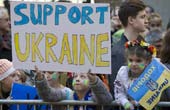High on hype, low on expectations
By Fu Mengzi (China Daily) Updated: 2014-04-23 06:57
US President Barack Obama's four-nation East Asian tour from Wednesday is aimed at pushing forward Washington's "pivot to Asia" policy. First, his visits to Japan, the Republic of Korea, Malaysia and the Philippines show the US is determined to consolidate its military presence and use its diplomatic power to ensure the success of the policy.
The past year has seen the US taking several measures to further its "rebalancing" to Asia strategy, especially after the Ukraine crisis that has brought it in direct confrontation with Russia, a rare occurrence since the end of the Cold War.
Of course, some American observers say Russia is using the US' "rebalancing" strategy, which has forced Washington to divert attention from Europe, to expand its sphere of influence in Europe. Therefore, they say, the US needs to shift its focus to Europe. But such voices seem to have drowned in the rising sound wave of so-called American experts on Asia, who say the US should see a rising China as its biggest rival and, hence, stay focused on its "rebalancing" strategy.
Second, the US sees a new opportunity of reshaping the landscape of the Asia-Pacific, where the situation now is unstable. Tensions on the Korean Peninsula have escalated again despite the Democratic Republic of Korea and the Republic of Korea holding a reunion ceremony earlier this year for separated families. And although Obama helped bring together ROK and Japanese leaders for their first face-to-face talks on the sidelines of a nuclear security summit in The Hague, relations between Seoul and Tokyo show no signs of improving because of their differences over Japan's colonial past.
Moreover, relations between China and Japan are not likely to improve any time soon because of Tokyo's adamant stance, and tensions are rising over the territorial disputes in the South China Sea.
So, during his visit to East Asia, Obama's goal will be to integrate US allies in the region by trying to broker a deal between the ROK and Japan, strengthening US-ROK security partnership (through more joint military drills) and reassuring the Philippines of US support in its dispute with China. The reason is simple: Washington wants to remove all obstacles that could derail its "pivot to Asia" policy.
There is little doubt that the US' "rebalancing" strategy is aimed at China, because despite vowing not to take sides in the East China Sea and South China Sea disputes, it has been backing Japan and the Philippines. And for Japan and the Philippines, eager as they are to curb China's rise by flaunting the US muscle, Obama's visit signifies support for their actions.
Third, Obama will also promote negotiations on the Trans-Pacific Partnership. The ROK and Canada concluded their negotiations for a free trade agreement in March, and Japan recently signed a free trade agreement with Australia in a bid to win more chips for TPP negotiations with the US. Though officially the ROK has not announced that it would join the TPP, it has hinted at doing so. Obama will, therefore, persuade the four countries to expedite the TPP negotiations. After all, the TPP would account for 40 percent of the world's GDP and will enable the US to double its exports and maintain its leading role in making rules for economic and trade liberalization in the Asia-Pacific.
China, however, should not worry too much about the impact of Obama's visit on the region. Japan and the Philippines will indeed seek US support in their maritime disputes with China, but that doesn't mean Obama's visit to Asia is aimed against China.
Since Obama is aware of some of the wishful thinking and calculations of some of the US allies, his strategy will be to avoid being dragged into a confrontation with China. Obama will reaffirm the US' commitment toward its allies but he will also warn them against taking any action that could aggravate the situation.
China and the US both know the importance of their relations and are making efforts to build a "new type of major-power relationship". Besides, enough mechanisms are in place to resolve the frictions that occasionally crop up between Beijing and Washington. The two countries know that they have to respect each other's core interests, avoid third-party interference and refrain from using words or taking actions that could worsen matters.
A stable and mature China-US relationship is needed to address the complicated challenges and determine the future of the Asia-Pacific as well as the rest of the world. Perhaps Obama's visit to Beijing to attend the APEC meeting later this year will signal the beginning of the reshaping of the Asia-Pacific landscape.
The author is vice-president of China Institutes of Contemporary International Relations.
The opinions expressed on this page do not necessarily reflect those of China Daily.










